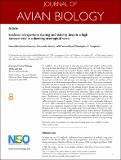Files in this item
Evidence of repertoire sharing and stability despite a high turnover rate in a duetting neotropical wren
Item metadata
| dc.contributor.author | Quiros Guerrero, Esmeralda | |
| dc.contributor.author | Janeiro Silva, Maria Joao | |
| dc.contributor.author | Cresswell, Will | |
| dc.contributor.author | Templeton, Christopher Neal | |
| dc.date.accessioned | 2020-06-15T10:30:03Z | |
| dc.date.available | 2020-06-15T10:30:03Z | |
| dc.date.issued | 2020-06 | |
| dc.identifier | 267209140 | |
| dc.identifier | b6dc1c52-6d68-4b7e-9e03-ccea6680e8e8 | |
| dc.identifier | 85088169839 | |
| dc.identifier | 000553360800002 | |
| dc.identifier.citation | Quiros Guerrero , E , Janeiro Silva , M J , Cresswell , W & Templeton , C N 2020 , ' Evidence of repertoire sharing and stability despite a high turnover rate in a duetting neotropical wren ' , Journal of Avian Biology , vol. 51 , no. 6 , e02382 . https://doi.org/10.1111/jav.02382 | en |
| dc.identifier.issn | 0908-8857 | |
| dc.identifier.other | ORCID: /0000-0002-4684-7624/work/75996629 | |
| dc.identifier.uri | https://hdl.handle.net/10023/20082 | |
| dc.description | Funding: 1st author was supported by a PhD scholarship (381393/327118) funded by the Consejo Nacional de Ciencia y Tecnología (CONACYT). 2nd author was supported by a PhD scholarship (SFRH/BD/96078/2013) funded by the Fundação para a Ciência e Tecnologia (FCT). This research was funded by grants and fellowships from NERC (NE/J018694/1), the Royal Society (RG2012R2), and MJ Murdock Charitable Trust (2014199). | en |
| dc.description.abstract | In songbirds, the spatial pattern of song sharing among individuals is influenced by the song learning and dispersal strategies within each species. In birds where females and males sing and create joint acoustic displays (duets), the processes defining the patterns of song sharing become more complex as there might be different selection pressures shaping the behaviour of each sex. To provide further insight into the vocal development and the dispersal strategy of duetting tropical species, we investigated the patterns of individual and pair repertoire sharing, as well as the stability of these repertoires, in a colour‐marked population of riverside wrens, Cantorchilus semibadius, located in the Osa Peninsula, Costa Rica. Using data collected over a five‐year period, we found considerable variation in the sharing levels of phrase and duet type repertoires among neighbouring individuals coupled with a general decline of repertoire sharing as distance increased between birds’ territories. These results are consistent with a pattern predicted in age‐restricted learners that establish preferentially near their tutors. Furthermore, we found no evidence of individuals changing their phrase type repertoires over time, including after remating events. Duet type repertoires were also stable when pairs remained together. However, we observed a surprisingly high turnover rate. When individuals remated, even though the majority of the previous duet type repertoire remained, several new duet types were included. Taken together, our findings suggest that riverside wrens might create their individual repertoires by copying their same‐sex parent and neighbouring individuals before dispersal. Additionally, we speculate that even though birds were able to create new duet types after changing partners, a substantial portion of their duet type repertoire might also be copied from their parents and neighbouring pairs during the initial critical period of song learning. | |
| dc.format.extent | 12 | |
| dc.format.extent | 854778 | |
| dc.language.iso | eng | |
| dc.relation.ispartof | Journal of Avian Biology | en |
| dc.subject | Duet type | en |
| dc.subject | Phrase type | en |
| dc.subject | Repertoire sharing | en |
| dc.subject | Repertoire stability | en |
| dc.subject | Riverside wren | en |
| dc.subject | Turnover rate | en |
| dc.subject | QH301 Biology | en |
| dc.subject | DAS | en |
| dc.subject.lcc | QH301 | en |
| dc.title | Evidence of repertoire sharing and stability despite a high turnover rate in a duetting neotropical wren | en |
| dc.type | Journal article | en |
| dc.contributor.sponsor | NERC | en |
| dc.contributor.institution | University of St Andrews. School of Biology | en |
| dc.contributor.institution | University of St Andrews. Centre for Biological Diversity | en |
| dc.contributor.institution | University of St Andrews. Scottish Oceans Institute | en |
| dc.contributor.institution | University of St Andrews. Institute of Behavioural and Neural Sciences | en |
| dc.contributor.institution | University of St Andrews. St Andrews Sustainability Institute | en |
| dc.identifier.doi | https://doi.org/10.1111/jav.02382 | |
| dc.description.status | Peer reviewed | en |
| dc.identifier.grantnumber | NE/J018694/1 | en |
This item appears in the following Collection(s)
Items in the St Andrews Research Repository are protected by copyright, with all rights reserved, unless otherwise indicated.

